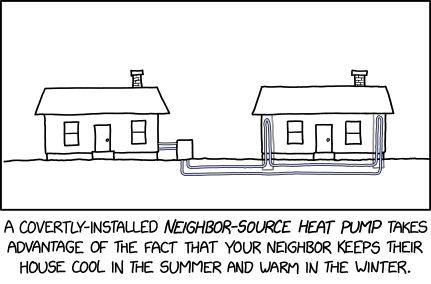Neighbor-Source Heat Pump

The installation of the pipes on the inside of the insulation can be challenging, especially when the neighbor could come home at any minute.

The installation of the pipes on the inside of the insulation can be challenging, especially when the neighbor could come home at any minute.
Since the energy crisis of the 1970s, electric air source heat pumps have been offered as a more efficient alternative to burning fuel. Much like the operation of a typical refrigerator or air-conditioner, heat pumps use a relatively small amount of power to move heat to where it is most needed (away from where heat is not required or deeper cold can be tolerably dispersed). This is most commonly and conveniently done using a heat exchanger installed on the outside wall of the building/apartment, which can extract heat from the ambient outside air and use that to heat the inside of the household, concentrating the energy to provide temperatures typically over and above those originally present in either location. Because of the varying nature of the external climate, this is less efficient (or at least more technically difficult) in colder weather, the time when the heating would be most appreciated. Although the effectiveness of cold climate heat pumps has significantly improved in recent decades, heat pumps still suffer from a poor reputation compared to combustion heating due to their poor cold weather performance, resulting in discomfort, high electricity usage/cost, or both.
An alternate method of harvesting heat is the ground source heat pump. This does the same job of extracting heat energy from its surroundings (pipes sent deep into the ground, rather than just being exposed to the air by the side of the building), and benefits from the more constant temperature of the pedosphere (or deeper), which is often below the frost-line, always giving a relatively warm heat-source to extract energy from, even in the depths of winter. If set up to also cool a home, in warm conditions, it also finds the same reliably small range of ground-temperatures useful in being cooler than the ambient air of summer, thus being more suited to disperse excess heat into whilst cooling the indoor environment. A further method, the water source heat pump, similarly makes use of a sufficiently large body of water's tendency to provide a near constant 4°C temperature (whatever the external conditions) in its depths.
In this comic, Randall goes further and finds a handy source of heat (in winter) and cold (in summer)… the house of a neighbor, which is itself being actively maintained (perhaps by more traditional heating and cooling technology) at a temperature which approaches his own preference for temperature. Being thermally inverted to the current seasonal conditions, it would be even more economical to tap into for heat during cold times and coolness during the warmer ones. That is, it would be for Randall, not the neighbor who is now forced to effectively air-condition two buildings, instead of the one they thought they were maintaining. This is accomplished by sending the pipes (that might have been just buried in the ground) from the heat-exchange unit off into the walls of the neighboring house to tap into the artificially-maintained temperature there.
While the small-scale application suggested here can thus be assumed to cause neighborly trouble, this concept has been in use at much larger scales for about the last ten years with virtually no repercussions — which is largely due to the tapped neighboring premises not being residential buildings. On top of this, district heating, or "neighborhood heating" is a real system where a centralized heat source provides heating for multiple buildings in the neighborhood, either through a dedicated heat source (created to exploit the economies of scale) just for this purpose, or else taking waste heat from some other local amenity (e.g. a waste incinerator) that is producing sufficient quantities to spare as a side-effect of its core operation. This is humorously in contrast to the comic where someone steals heat from one of their neighbors as one might steal Cable TV.
The title text addresses some of the issues involved when trying to properly install the Neighbor-Source Heat Pump, without the neighbor realizing that they are about to be leeched from in this way. It may already be quite difficult to interfere with the structure of the neighbouring house (in this case, by feeding pipes up into at least two of its wall cavities) without this being noticed once the absent neighbour returns, but to do so under the imminent risk of being observed at work by the neighbor arriving home would take even more care to accomplish.
This was the first of two comics in a row that advocate putting things in other people's walls, as this was followed by 3100: Alert Sound.